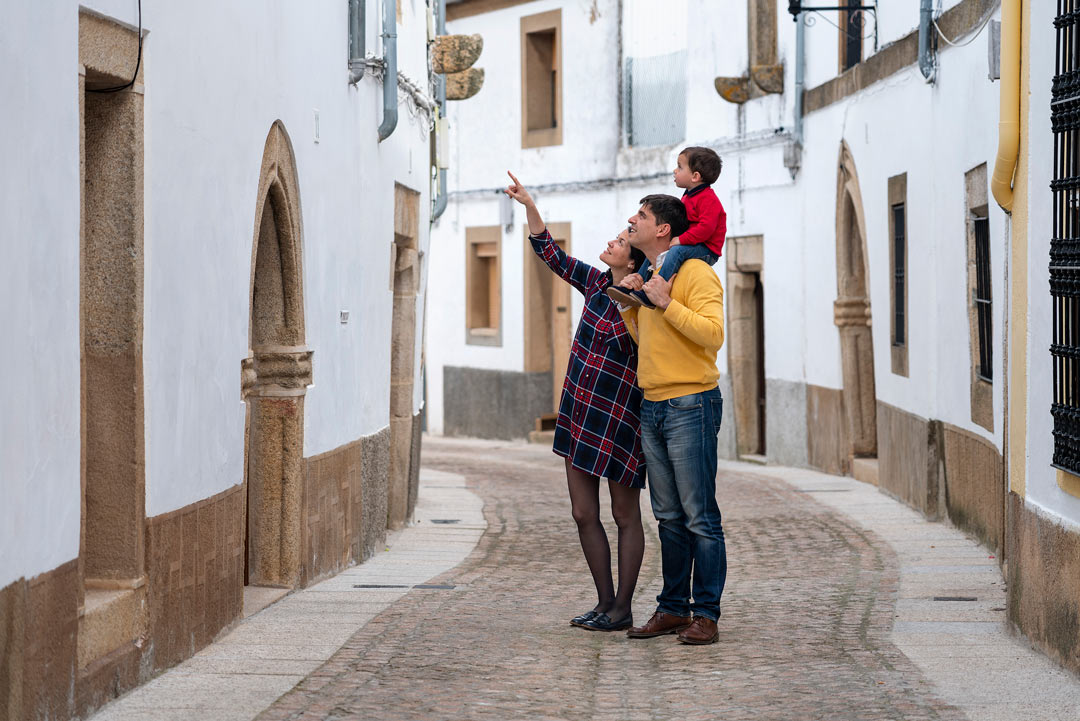Valencia de Alcántara
The town of the three cultures
Contact
Tourist Office of Valencia de Alcántara
Plaza de Gregorio Bravo, S/N
10500 Valencia de Alcántara, Cáceres (Extremadura)
Valencia de Alcántara is located in the heart of La Raya of Portugal and Extremadura in the natural district of the Sierra de San Pedro and the Tajo Internacional Nature Reserve. It has a Mediterranean climate with slight Atlantic influences and in its ecosystem cork oak and holm oak woodland abounds to provide a perfect habitat for species such as the Spanish imperial eagle, the black stork, and the griffon vulture.
The richness of the landscape of Valencia de Alcántara is enviable, especially in the district of La Campiña and its hamlets of La Aceña de la Borrega, Alcorneo, La Fontañera, Jola, Las Lanchuelas, El Pino, Puerto Roque, Las Casiñas, Las Huertas de Cansa, and San Pedro de los Majarretes which make it a place to lose yourself so as to enjoy the most pleasant spots which nature gives us.
The visitor can enjoy not only a rich natural heritage but also an important historical and artistic heritage consisting of its Gothic Quarter, the Archpriest Church of Santa María de Rocamador, the Church of La Encarnación, the former Convento de Santa Clara (the Tourist Office and the Ethnographical Museum); the Town Hall; and the Castle-Fortress (the Early Settlers Identity Centre), without forgetting its megalithic complex which is considered to be one of the most important in Europe.
Curious fact: On 7th October 1497 at the Archpriest Church of Santa María de Rocamador the Royal Wedding was held of the Infanta Isabel, the daughter of the Catholic Monarchs, and the Prince (later King) of Portugal Manuel the Fortunate.This event is commemorated in the village every year thanks to the Royal Wedding Cross-border Festival. It was declared a Festival of Regional Tourist Interest in 2016 and is held the first week in August. In it the royal wedding is reproduced and there are also concerts, hiking routes, children’s workshops, and the Tapas Route, all in a Renaissance atmosphere.
The tasty gastronomy is another of the town’s strong suits with its traditional cooking which has survived over time; it is noted for its dishes deriving from the Iberian pig (stuffed pig’s stomach, black pudding), fried lamb, chanfaina stew, and also breadcrumbs and gazpacho.
The main festivals of the calendar are those of Los Mayos and the Cross of May at the start of the month, the Fair of San Isidro Labrador on 15th May, the “Royal Wedding” Cross-border Days in early August (which have been declared a Festival of Regional Tourist Interest) and the Festival of the Patron Saint San Bartolomé in late August.
You can’t leave without seeing…
Valencia de Alcántara has what is considered to be one of the best megalithic complexes in Europe with over 40 dolmens. These funeral monuments have been dated as being from between the 3rd and 4th millennium B.C. and were declared an Asset of Cultural Interest in the category of Archaeological Area in 1992. Many of them can be visited on the marked routes in the area such as La Zafra, Tapada del Anta, El Mellizo, Data I and II, and Cajirón I and II. The latter are included on the Route of Aceña de la Borrega, which is within the Natural Monument of the Landscape of La Data.
This is one of the most extensive quarters of the province of Cáceres with 19 streets and more than 260 doorways whether with lintels, pointed, or in other styles. It was declared an Asset of Cultural Interest in the category of Historical-Artistic Ensemble in 1997 and includes the 15th-century Synagogue which has been converted into a Sephardic Culture Identity Centre.
Strolling in its streets will take the visitor back to past ages as at every step he/she will discover part of its historical and cultural legacy in the form of a coat of arms, a stately home, a mark, or even the aroma of traditional cooking given off by certain streets.
This Gothic church was declared a national Historical-Artistic Monument in 1982. It beauty can be seen both inside and outside the building and it also contains several artistic surprises to be discovered by the visitor. These include a baroque altarpiece restored by the workshop of José de Churriguera, a polychrome carving of Christ attributed to Berruguete, and an image painted on eight assembled panels by Luis de Morales.
Before its expulsion in 1492 as a result of the Alhambra Decree, the Hispanic/Jewish community and the converted Jews who remained left a mark which is still palpable and which deserves to be revealed and emphasised. Traces of their trades, their rituals and religious objects, their festivals, their language (Ladino), and the structure and meaning of the space which constitutes the synagogue have been left in the spaces they inhabited such as the Jewish quarters of Valencia de Alcántara, Alcántara, and Brozas.
Many of the Sephardic families who inhabited this territory were obliged to flee to Portugal after the decree and settle in the Jewish communities of Castelo de Vide, Castelo Branco, or Belmonte, among others. Their influence and legacy have made Tajo Internacional a territory where the Sephardic stamp continues to be found in its streets, buildings, and gastronomy, i.e. the whole of the cultural and intellectual legacy which this community left behind it.






